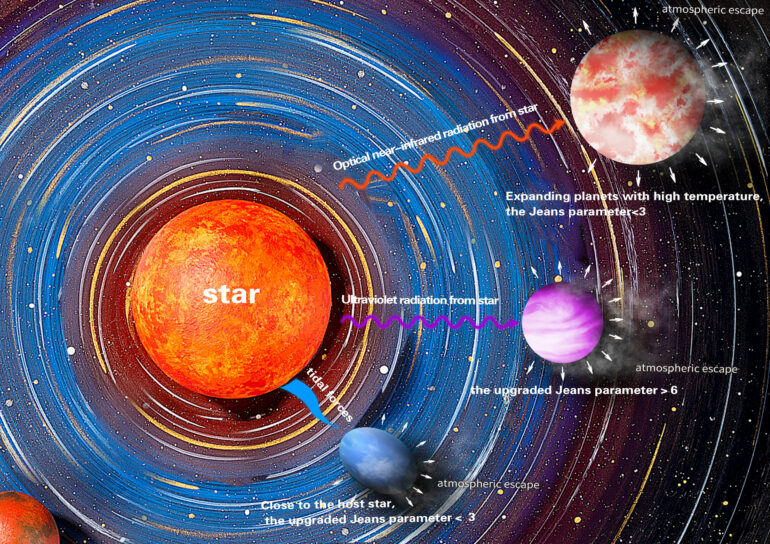A study published in Nature Astronomy and conducted by Guo Jianheng from the Yunnan Observatories of the Chinese Academy of Sciences offers a perspective on the violent atmospheric escape processes of low-mass exoplanets, specifically a process known as hydrodynamic escape.
It reveals various driving mechanisms affecting the hydrodynamic escapes and proposes a new classification method to understand these escape processes.
Exoplanets, which refer to planets outside our solar system, are a popular subject in astronomical research. The atmospheres of these planets can leave the planet and enter space for various reasons. One such reason is hydrodynamic escape, which is the process of the upper atmosphere leaving the planet as a whole. This process is much more intense than the particle behavior escape observed in the solar system’s planets.
Hydrodynamic atmospheric escape might have happened in the early stages of the solar system’s planets. If Earth had lost its entire atmosphere via hydrodynamic escape at that time, it might have become as desolate as Mars. Now, this intense escape no longer happens on planets like Earth. However, space and ground telescopes have observed that hydrodynamic escape still occurs on some exoplanets that are very close to their host stars. This process not only changes the planet’s mass but also affects the planet’s climate and habitability.
In this study, Guo Jianheng found that the hydrodynamic atmospheric escape of low-mass exoplanets could be driven either solely or jointly by the planet’s internal energy, the work done by the star’s tidal forces, or heating by the star’s extreme ultraviolet radiation.
Before this study, researchers had to rely on complex models to figure out which physical mechanism drove the fluid escape on a planet, and the conclusions were often obscure. This study proposed that just using the basic physical parameters of the star and planet, such as mass, radius, and orbital distance, can classify the mechanisms of hydrodynamic escape from low-mass planets.
On planets with low mass and large radius, sufficient internal energy or high temperature can drive atmospheric escape. This study showed that using the classic Jeans parameter, a ratio of the planet’s internal energy to potential energy, can determine whether the aforementioned escape occurs.
For planets where internal energy cannot drive atmospheric escape, Guo Jianheng defined an upgraded Jeans parameter by introducing tidal forces from stars. With the upgraded Jeans parameter, the roles of the star’s tidal forces and extreme ultraviolet radiation in driving atmospheric escape can be easily and accurately distinguished.
In addition, this study revealed that planets with high gravitational potential and low stellar radiation are more likely to experience a slow hydrodynamic atmospheric escape; otherwise, the planet will primarily undergo rapid fluid escape.
The findings of this study elucidate how a planet’s atmosphere evolves over time, which is important for exploring the evolution and origins of low-mass planets and could help better understand the habitability and evolutionary histories of these distant worlds.
More information:
J. H. Guo, Characterization of the regimes of hydrodynamic escape from low-mass exoplanets, Nature Astronomy (2024). DOI: 10.1038/s41550-024-02269-w
Provided by
Chinese Academy of Sciences
Citation:
Study reveals mechanisms of hydrodynamic escape in low-mass exoplanets (2024, May 10)



